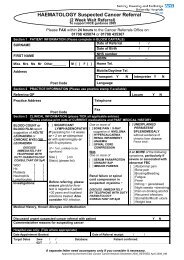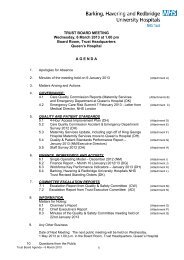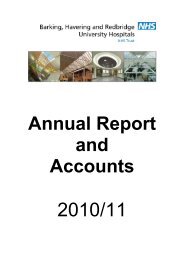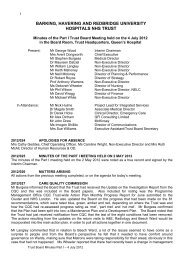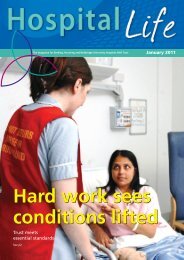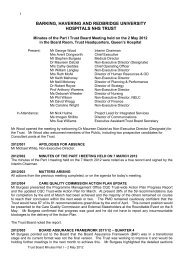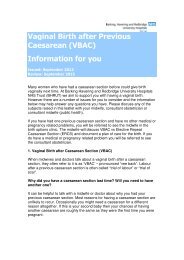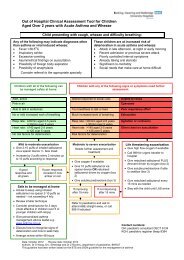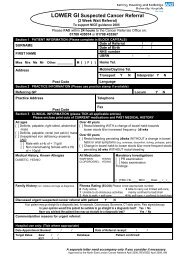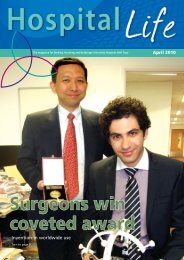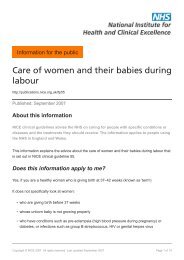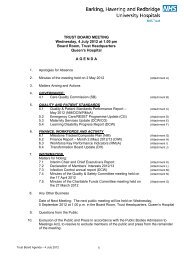BHRUT annual report 2009 - Barking Havering and Redbridge ...
BHRUT annual report 2009 - Barking Havering and Redbridge ...
BHRUT annual report 2009 - Barking Havering and Redbridge ...
Create successful ePaper yourself
Turn your PDF publications into a flip-book with our unique Google optimized e-Paper software.
48<br />
<strong>Barking</strong>, <strong>Havering</strong> & <strong>Redbridge</strong> University Hospitals NHS Trust<br />
received <strong>and</strong> the amount of the receivable can be<br />
measured reliably.<br />
1.20 Clinical negligence costs<br />
The NHS Litigation Authority (NHSLA) operates a risk<br />
pooling scheme under which the trust pays an <strong>annual</strong><br />
contribution to the NHSLA which in return settles all<br />
clinical negligence claims. The contribution is charged<br />
to expenditure. Although the NHSLA is<br />
administratively responsible for all clinical negligence<br />
cases the legal liability remains with the trust. The<br />
total value of clinical negligence provisions carried by<br />
the NHSLA on behalf of the trust is disclosed at note<br />
35.<br />
1.21 Non-clinical risk pooling<br />
The Trust participates in the Property Expenses Scheme<br />
<strong>and</strong> the Liabilities to Third Parties Scheme. Both are<br />
risk pooling schemes under which the trust pays an<br />
<strong>annual</strong> contribution to the NHS Litigation Authority<br />
<strong>and</strong>, in return, receives assistance with the costs of<br />
claims arising. The <strong>annual</strong> membership contributions,<br />
<strong>and</strong> any excesses payable in respect of particular<br />
claims are charged to operating expenses as <strong>and</strong> when<br />
they become due.<br />
1.22 EU Emissions Trading Scheme<br />
The Trust is not part of the EU Emissions Trading<br />
Scheme.<br />
1.23 Contingencies<br />
A contingent liability is a possible obligation that arises<br />
from past events <strong>and</strong> whose existence will be<br />
confirmed only by the occurrence or non-occurrence<br />
of one or more uncertain future events not wholly<br />
within the control of the trust, or a present obligation<br />
that is not recognised because it is not probable that a<br />
payment will be required to settle the obligation or<br />
the amount of the obligation cannot be measured<br />
sufficiently reliably. A contingent liability is disclosed<br />
unless the possibility of a payment is remote.<br />
A contingent asset is a possible asset that arises from<br />
past events <strong>and</strong> whose existence will be confirmed by<br />
the occurrence or non-occurrence of one or more<br />
uncertain future events not wholly within the control<br />
of the trust. A contingent asset is disclosed where an<br />
inflow of economic benefits is probable.<br />
Where the time value of money is material,<br />
contingencies are disclosed at their present value.<br />
1.24 Financial assets<br />
Financial assets are recognised when the Trust<br />
becomes party to the financial instrument contract or,<br />
in the case of trade receivables, when the goods or<br />
services have been delivered. Financial assets are<br />
derecognised when the contractual rights have expired<br />
or the asset has been transferred.<br />
Financial assets are initially recognised at fair value.<br />
Financial assets are classified into the following<br />
categories: financial assets at fair value through profit<br />
<strong>and</strong> loss; held to maturity investments; available for<br />
sale financial assets, <strong>and</strong> loans <strong>and</strong> receivables. The<br />
classification depends on the nature <strong>and</strong> purpose of<br />
the financial assets <strong>and</strong> is determined at the time of<br />
initial recognition.<br />
Financial assets at fair value through profit <strong>and</strong><br />
loss<br />
Embedded derivatives that have different risks <strong>and</strong><br />
characteristics to their host contracts, <strong>and</strong> contracts<br />
with embedded derivatives whose separate value<br />
cannot be ascertained, are treated as financial assets<br />
at fair value through profit <strong>and</strong> loss. They are held at<br />
fair value, with any resultant gain or loss recognised in<br />
calculating the trust’s surplus or deficit for the year.<br />
The net gain or loss incorporates any interest earned<br />
on the financial asset. Fair values have been<br />
determined with reference to market values or<br />
internally developed models to derive an<br />
approximation to market values where not available<br />
Annual Accounts


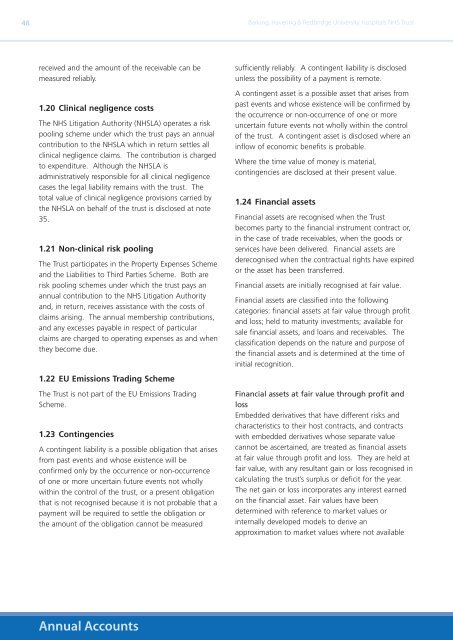
![[4] Biopsy Leaflet.pub - Barking, Havering and Redbridge University ...](https://img.yumpu.com/51285530/1/190x134/4-biopsy-leafletpub-barking-havering-and-redbridge-university-.jpg?quality=85)

